The Talk Sea Fishing How To Catch Guide on brill fishing. We take a look at the tactics, techniques and locations to catch yourself a brill.
A true fact is that during Roman times, both large brill and turbot were often offered to people of high status to gain favours and help so-called lesser mortals to advance in life.
Brill has become a fish of "special" interest to sea anglers and especially species hunters due to their more localised distribution in many areas.
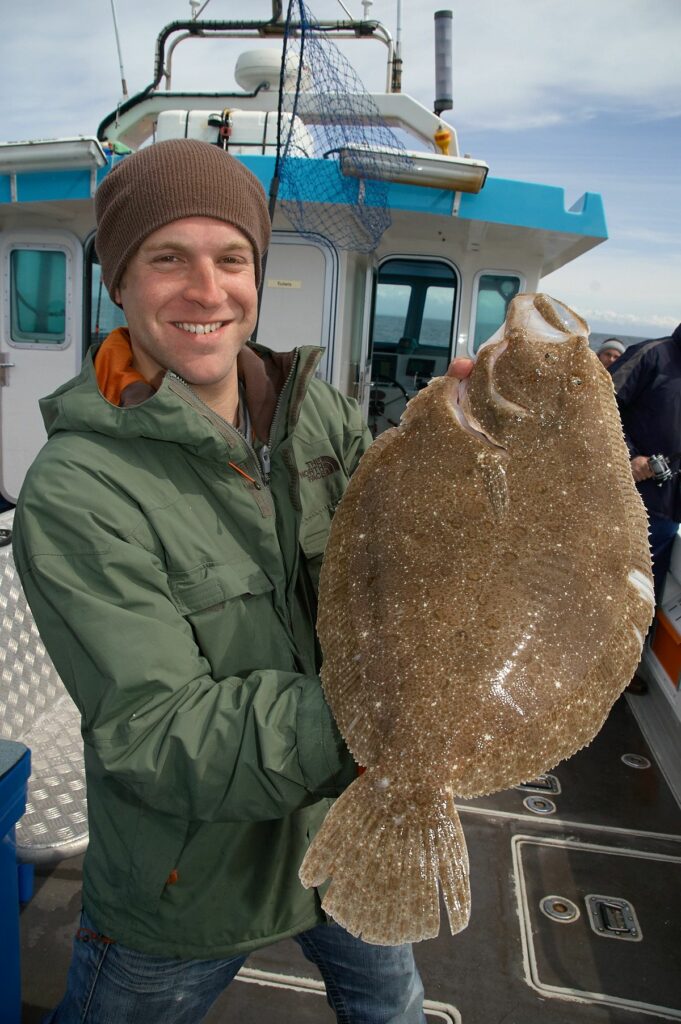
Just the body shape of the brill compared to the turbot is enough to distinguish the two apart. The turbot is more diamond-shaped, but the brill more elongated. The dorsal fin on the brill travels almost to the edge of the mouth but ends by the eyes on the turbot. Also, note that the first rays of the dorsal fin are free of the fin rays for up to half their length.
The brill has a smoother skin than the turbot, the latter being covered in small tubercles or raised bumps. The colouration of the brill is normally a dull sandy brown with occasional scattered small darker and lighter spotting with a creamy white belly. The camouflage flecking does not extend on to the tail fin on the brill, but does on the turbot.
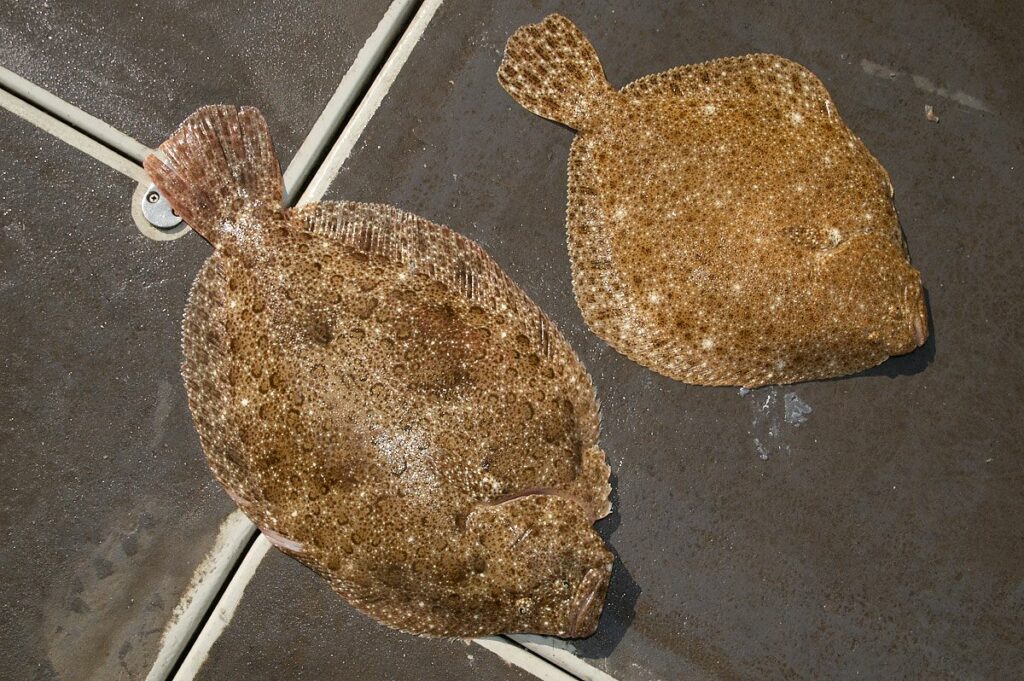 On the left is a brill and on the right is a turbot, notice the longer body of the brill.
On the left is a brill and on the right is a turbot, notice the longer body of the brill.
Brill are found throughout the Mediterranean and into the Black Sea where they are at their most common. They are present northward taking in the Spanish and Portuguese coast, France, and though less common they also inhabit the North Sea and as far as the Danish coast and southern Norway, though their numbers here are very limited.
The brill is at the northern extreme of its natural range then but found all around the UK and Ireland, though predominantly in the southern half of the country, especially along the southern and western coasts.
It spawns in late spring and early summer. The larvae are pelagic initially ensuring an even distribution around the coastline, but at a length of between 0.75-inch and 1.25-inches, they revert to a bottom-dwelling existence with the right eye moving from the right to the left side and in close proximity to the left eye.
They are found mainly over clean sand, especially in areas of undulating sandbanks, but will occasionally be caught over fine shingle or pea gravel, also sandy mud, with some bigger specimens caught tight into wrecks and reefs on sand.
The smaller fish can be found fairly tight inshore in depths of around 30-feet, but the bigger adults will be on offshore sandbanks mostly in depths between 50-feet and 200-feet.
Juvenile brill of hand size or smaller can occasionally be caught along our western surf beaches, though this is not common.
The adult fish are adaptive and will interchange between scavenging on the seabed when necessary, taking worms and crustaceans. They'll take squid, but their main diet is prey fish such as sandeels, whiting, small codling, and when living close to reefs or wrecks they'll add pouting, poor cod and rockling.
Brill caught by anglers are usually up to about 5lbs, but with bigger ones occasionally taken. Their natural ceiling weight is around 15lbs, and indeed, the current UK record for the species is 16lbs, but was taken in 1950 when commercial fishing pressures were far less, and species had a chance to reach full size.
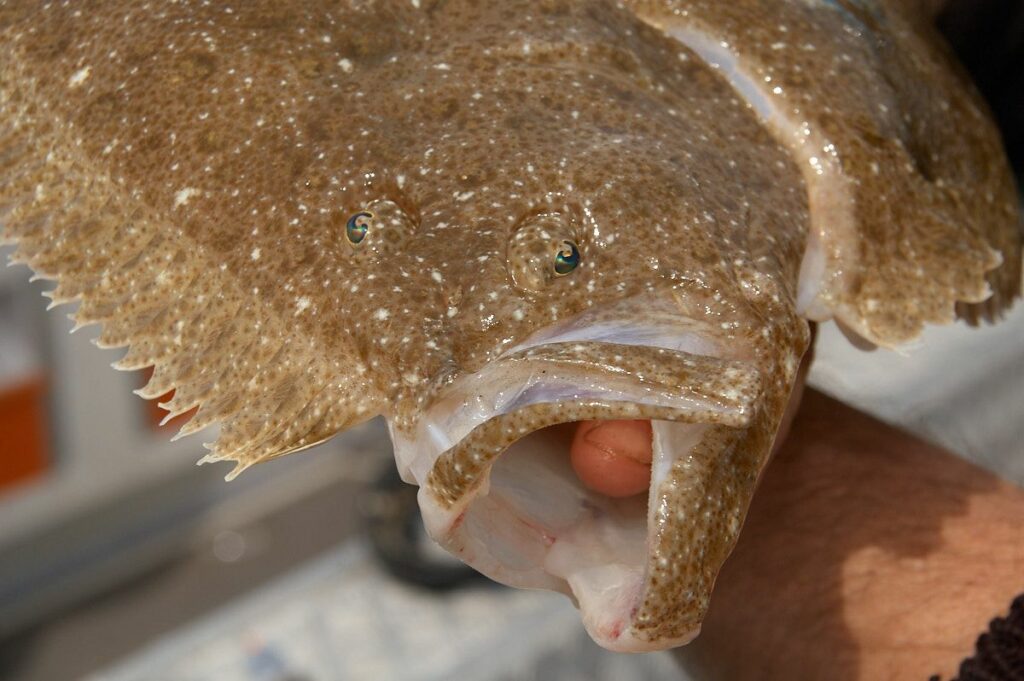
As with so many species, brill can technically be caught for the full 12 months of the year. However, the traditional season for this species is from May through to November. You can pin this down further too, with the period August through to November often seeing the best numbers of brill and the biggest fish in the southern half of the UK. Further northward, look at July to October as potentially the most productive.
When booking boat trips with brill in mind, for many areas the smaller neap tides will be the ones to choose. Due to the generally lighter tide runs the boat drift speed will be lower, so the fishing is not only easier, but the baits are fished at a speed that suits the brill.
It's no coincidence though that the brill's natural habitat is in amongst undulating sandbanks created by tidal flows. They like some tide flow, so in areas where the tide speed is not too fast, the bigger spring tides can also fish well.
As for the tide state, the best fishing tends to be after slack water about 1.5 hours into a new flood and for the next 2 hours or so. This is when there is a better chance of brill. Once the tide flow starts to ease, expect bites to slow with it.
On the ebb tide, the bite time is much the same. However, as the slack water periods occur, the brill will often move station swimming up off the downtide incline of a bank and reverting to the opposite side of the bank again to face into the tide as it travels over the sandbank. This sees any food brought along by the tide wash over the bank and down the incline where the fish are waiting to ambush both prey and loose feed. As they make this directional change at slack water, fish moving over the top of the bank can sometimes be caught, so bear it in mind, but you will need to move the bait if the drift speed is slow by inducing movement using the rod tip lifting it up or down to work the bait.
Looking in more detail at their preferred habitat, they will be resident anywhere where there are a series of shallowing rising sandbanks. They will take up station on the inclines of the bank facing directly into the tide as it flows over the top of the bank. This is a clever ploy as the tidal current pushes food over the top of the banks, and then it rolls downwards or is pushed downwards by the tidal currents, thus bringing food directly to the fish.
The typical areas on the inclines the brill prefer are either right at the base of the incline where it starts to rise, or up to midway up the incline. Banks formed from pea gravel or fine shingle will also hold brill in the same way. Whatever type of terrain you find, they like it mostly clean.
Having said that, brill can also sometimes be found over sand that is in close proximity to reef ground, or in amongst sandy patches surrounded by reef and rocky ground. They will also be found on clean ground, especially sandbanks formed by the tidal currents that sweep over wrecks. It's often the latter type of habitat that will produce the very biggest brill.
Due to brill often being found in shallower water, say on average, 75ft to 150ft, they are more susceptible to periods of rough seas and will move out into deeper areas if the weather pattern persists for more than a few days. Neither do they like coloured water, so expect the best returns to occur when the sea clarity is good with minimal suspended sediment.
The best fishing is during longer periods of fairly settled weather, light onshore breezes, overcast skies and lower light levels. As with so many forms of sea fishing, very bright days are less likely to fish well. The best days are the overcast days with cloud cover that limits light entering the water. A slight ripple or swell on the water is also good as this also cuts down on the amount of light able to travel down deep.
Perfect days for drift fishing are when there is a light wind against the tide's natural flow. This will produce a slower boat drift speed as the wind catches the boat and adds a slight braking effect that allows the anglers to fully cover the ground with their baits at a drift speed more conducive to the attack speed of brill.
For far too long, tackle used for brill was overly heavy and restrictive. A modern approach has been developed in recent years, and it improves the presentation of the bait.
In shallower water where the drift speed is not too fast, and lighter leads up to 6ozs can be used, a light 12lb class rod is ample and will land any brill that swims. Longer rods of 8ft are best with a fast action but with a slightly supple tip. The longer rods are easier to fish with over the boats' safety rails and keep a fish on the surface waiting to be netted well away from the boat. This reduces the possibility of a fish diving under the boat and cutting the line.
Experienced brill anglers were some of the first to revert away from standard multipliers and choose the more modern low-profile reels such as those from Abu Revo series. Modern reels of this style are the PENN Fathom Low-Profile series. The hint is in the name. These reels are designed to sit lower on the rod when in the reel seat with the gearbox below the reel seat line. This gives much better balance to the rod, and for those anglers that have trouble with sideways rock when reeling in, the low-profile reels help reduce this.
These reels still have a good line capacity in the 3000 sizing and will take well over 300-yards of 20lb braid, which is all you need. Braid has a much smaller diameter than monofilament of the same breaking strain, so suffers way less tidal and water pressure meaning you can fish much lighter weights and still stay in full contact with the seabed. Braid is also non-stretch massively improving bite detection. Braid mainline will see you able to feel the weight bouncing along over the bank's sandy ripples and instantly feel the sudden "stop" effect on the bait when a fish takes, or feel the taps as the fish attacks the bait. Mono stretches far too much, and you'll struggle to feel what's happening at the hook end, and as a result, you'll miss a lot of bites.
The modern low-profile reels have a level-wind system. We still prefer to use a light 20lb fluorocarbon leader. To allow this to travel easily through the level-wind eye, you need to use a slimline leader knot. The very best is the Albright Knot. This is easy to tie and tightens up into a neat and very slim knot. It is the only knot to use. Standard back to back Grinner knots and others form a too bulky knot, which may struggle to travel cleanly through the eye of the level-wind.
There is no option in deeper water and faster tides but to use heavier lead weights. In this case, we recommend a 12/20lb rod, again with a fast action and 8ft length, but go for a bigger reel. Popular ones are the Penn Fathom 15LD, the single-speed being fine for this type of fishing, or reels of similar build from the Daiwa or Shimano stables. Load these reels with heavier 30lb raid and add a 30lb fluorocarbon leader a bit more than twice the rod's length. This allows enough leader length to have a fish on the surface for netting but with the strong leader already on the reel spool. The leader also reduces the chance of abrasion from the seabed when drift fishing, plus offers a distinct, clear visual separation between the terminal tackle and the main braid line.
There is some advantage in choosing lead weight shapes that will lift up little puffs of sand as the bait travels across the seabed. Watch leads are good, or choose a weight with a flat end where the connection eye is fixed as these will dig into the sand a little then lift also lifting sand. The brill will see the puffs of sand and often respond moving in towards the bait. We also use 4 to 5oz flat carp leads such as tractor leads. These have a teardrop shape with moulded nipples on the leads body. These fish well and again lift up spurts of sand.
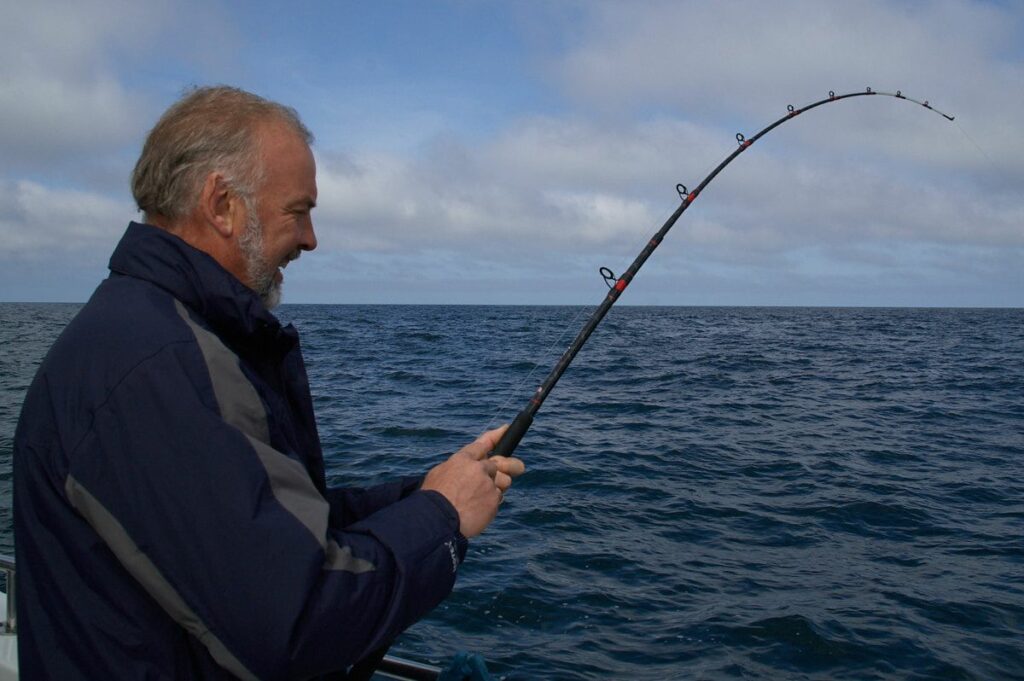
The TSF team tends to use a different rig for brill than we do for turbot. This is because the brill will not lift as far up off the seabed to intercept a passing bait as the turbot will. We prefer a simple sliding ledger rig with a shorter 3 to 4ft hook length, and this is how we tie it.
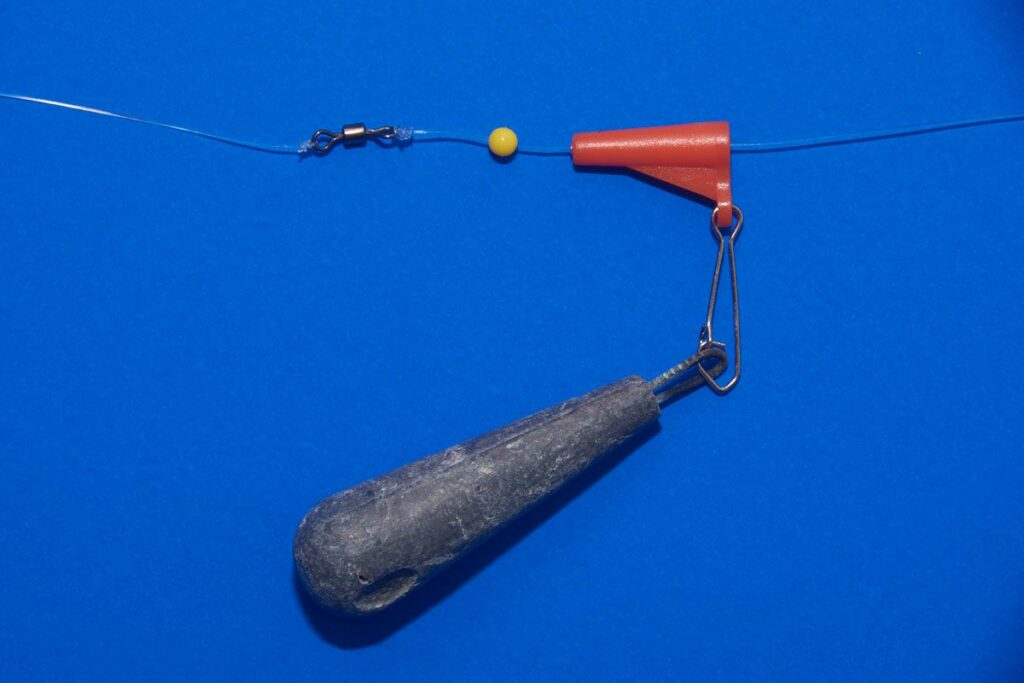
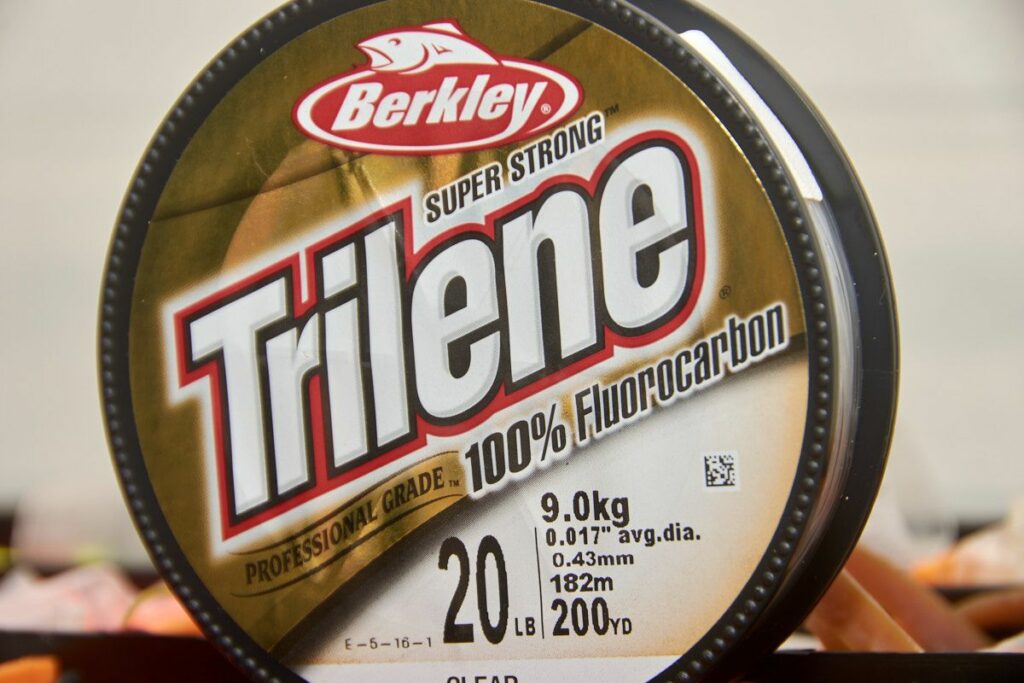
2. To the swivel, tie on three to four feet of 20 or 25lb fluorocarbon line.
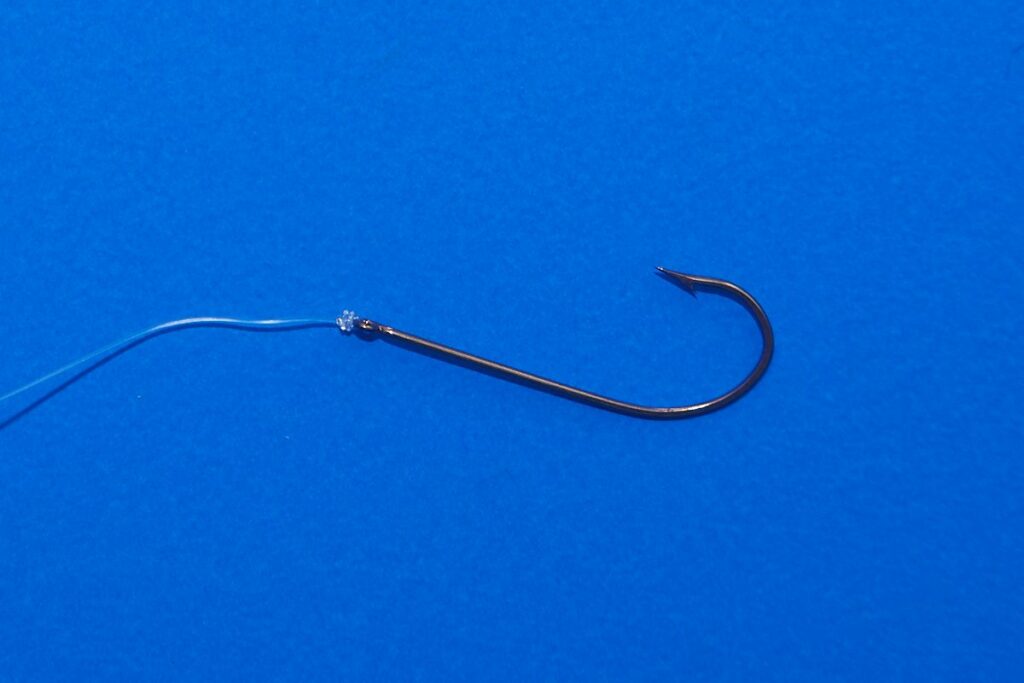
3. The hook needs to be an Aberdeen pattern size 1/0 or 3/0.
It's worth looking in a little more detail at this rig. Zip Sliders are usually orange or red, but Tronixpro does a clear one and in very clear water and shallower depths down to 100-feet, then the clear colour can give you an advantage and can get you more bites. We also use a clear or black coloured bead in these conditions, again as it's less obvious and more natural-looking. In deeper water and slightly coloured seas, the colour of terminal tackle is less important.
The fluorocarbon hook length is also less visible to fish, plus its slightly stiffer nature means it is less prone to tangling and presents the bait better. Being shorter at 3 to 5-feet in length, it keeps the hook bait tighter to the seabed, which is where the brill look to take their food. Just make sure you let the rig down semi slowly, briefly pausing occasionally to let the hook length re-extend, and when the lead weight hits the seabed, pull the rod tip back once or twice fairly quickly just to encourage the hook length to extend fully. Also, keep any tag ends on knots short so that the hook length cannot catch on them and hang up.
The brill also has a smaller mouth than the turbot. This is why we use hooks between 1/0 and never more than 3/0 and cut baits accordingly. A 1/0 is usually more than enough, but if you think you also stand a chance of a decent turbot, then the fish a 2/0 as the best overall compromise.
One thing we have found is that we catch just as many brill using a rig without any added colour or bling in the shape of beads etc. Sometimes though, on a faster drift, we would employ an attractor spoon, usually the ever productive Abu Rauto with just a short 6-inch to 10-inch hook trace of 25lb fluorocarbon. The spoon scuffs along the seafloor, kicking up sand and reflecting light and the brill will home in on this and investigate. Spoons, though, are more effective in shallower water where light levels penetrate. Over 150-feet in-depth and their consistency falls off.
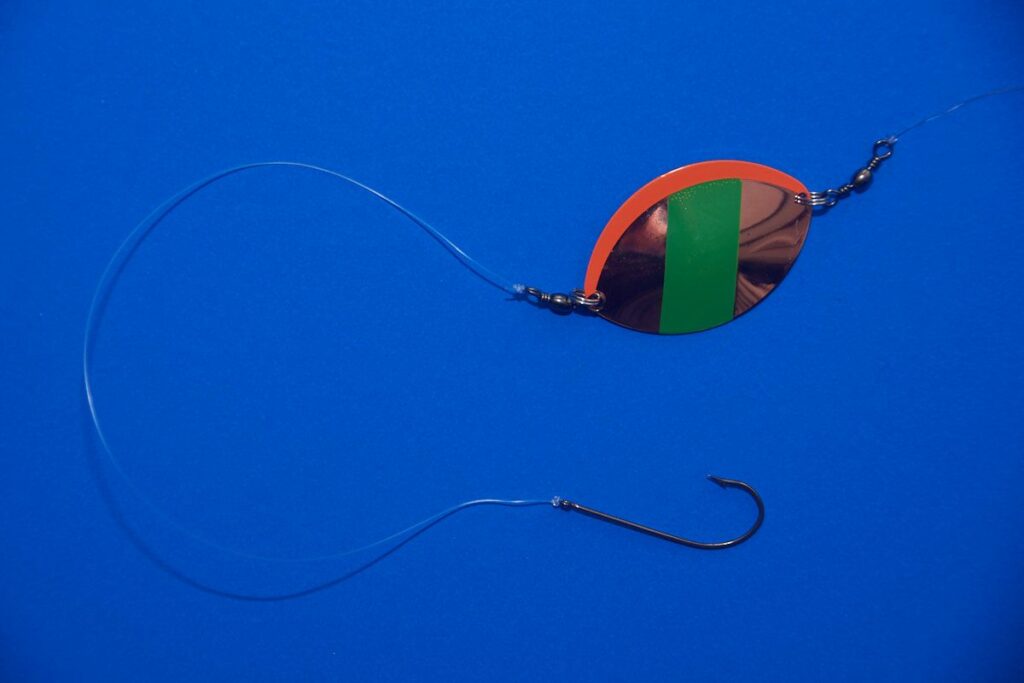
Just to give a different aspect of attractors, one thing you can try if the sea is carrying sediment and colour after a blow is to add some 5mm lumo beads just above the hook and bait. These will glow when deep and just give that hint of "see me" as the bait works across the seabed.
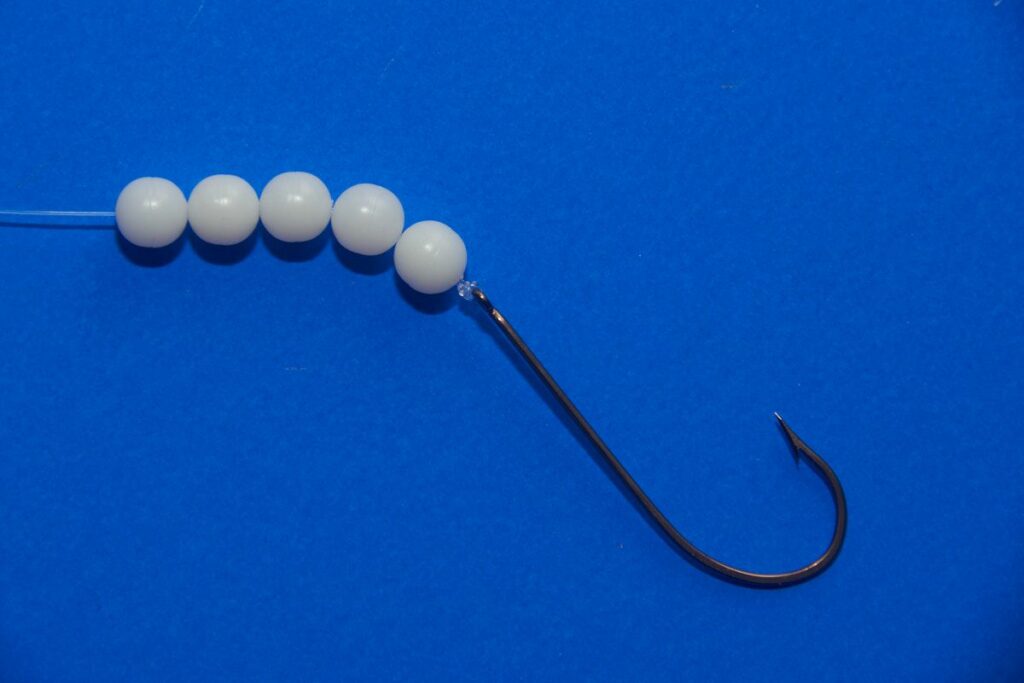
The prime food source for most brill is sandeel. Plus they have a mouth designed to take slimmer, longer baits. It makes sense then to cut your bait long and thin to imitate sandeels.
The way we do this is to use a small craft knife which are cheap in DIY shops or stores like The Range. Use a new blade every time. These allow a really neat and precise cut of the bait into thin slices.
The best way to do this is to remove a fillet from one side of a mackerel. Use a normal bait knife to cut the white belly section off the full fillet. Also, trim down the flesh's thickness on the white belly section so that some flesh remains, but the overall fillet is not overly thick. Lay the belly section on a bait board and cut strips about 4-inches long and no more than 1-inch at the top and taper the rest to a thinner point to produce a little more movement. Vary the sizes of the strips between 3-inches and 5-inches until you find out what the fish are taking best.
To hook the fillet, pass the hook through the skin side at the top of the thickest end, pull the hook fully through, lay the hook full length along the flesh side of the strip and pass the hook point back through from the flesh side to the skin side leaving the hook point well clear. Done like this the tag end of the knot will help hold the strip in place on the hook without using the bait elastic. Fresh mackerel is by far the best, and it works well in all situations, especially in water that carries colour after recent rough seas as it carries good scent.
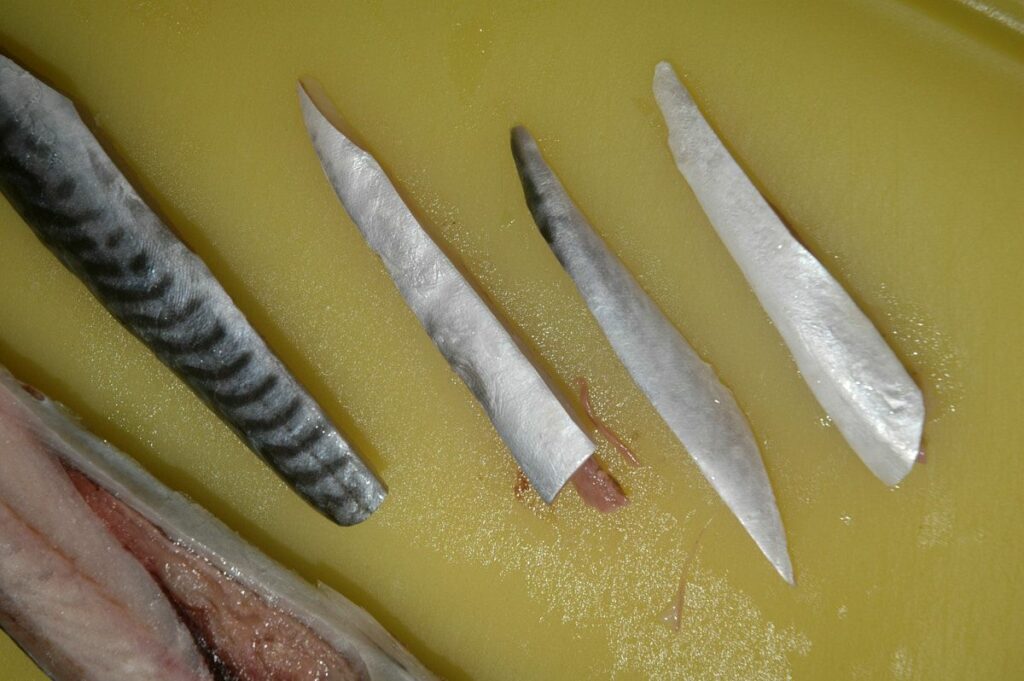
Also, try long strips of launce sandeel taken like a fillet off the body and presented the same. This can be deadly in all situations, but fishes best in clear water as it lacks the mackerel's scent.
Long strips of squid can also be good in clear water. The best way to prepare these is to cut the squid body fully open lengthways like a book. Scrape off all the skin to leave just the white flesh. Using the craft knife again, cut these strips as before around 3 to 5-inches in length and no more than an inch wide tapering the strip to a point at the other end. Present as we did the mackerel and sandeel.
Nothing comes close to the above three baits for brill. However, if you're struggling for these baits, strips of bluey, whiting, codling, pout and poor cod can work but are far less effective than sandeel and mackerel.
To add more movement, mount a smaller 2-3-inch strip of mackerel on to the hook, then add a long strip of squid which adds much more movement and increases the visual target in clear water.
During a slow controlled drift in ideal conditions, and if you're on the uptide side of the boat release somewhere between 75-yards and 100-yards of line, let the line tighten and note what happens to the lead weight. Can you feel it dragging heavily on the seabed, or maybe not feel it on the seabed at all with the line angle rising in the water? If the lead is too heavy, it will feel the same as it drags over the seabed. Change it for a slightly lighter lead until you can feel the lead tripping over the seabed but occasionally just lifting off it. This is perfect! If the lead is too light, then go heavier until you have constant contact with the seabed, but by lifting the rod tip, the weight will also easily lift and drop back down. Be prepared to do this constantly as tidal conditions and the drift speed changes. It is very important and gives you the very best presentation, ultimately catching you more fish.
On days when the drift speed is much quicker, then a tactic to try is to pay off at least twice the length of line as the depth you're fishing then tighten the line to allow the bait to travel across the sand. Every 30 seconds or so, release about 10-feet to 20-feet of line, more if you feel it necessary, to let the bait rest briefly on the seabed for a few seconds, then place your thumb on the reel spool to tighten the line again. This serves two purposes. By resting the bait on the seabed, it gives a brill the chance to catch up with the bait and eat it. Also, as you re-tighten the line, the static bait suddenly comes to life and darts forward in a natural manner. This sudden movement can trigger an attack from any close by brill as it looks like a sandeel or small prey fish either avoiding a predator or struggling to swim against the tide and appearing vulnerable.
If the boat is barely moving, as can be the case over slack water with little wind evident, then again slowly let line off until you have full and constant contact with the seabed and the line comes tight. Now gently pull the rod tip back a couple of feet or so and let the lead weight drop back again. This induces the "darting forward" motion that so many predators find impossible to resist when trying to ambush passing prey fish.
It's far less easy to fish if your boat position is on the downtide side of the boat. This means you are fishing directly under the boat, and many anglers feel this is a major disadvantage. Granted, it is not easy to fish like this, but let's analyse what we need to do to make the best of the situation. You need to choose a lead weight that is heavy enough to keep your line as vertical below the rod tip as is possible. If you start to creep back under the boat and continue to do so, your line angle lifts up towards the boat, you will eventually and inevitably tangle with anglers lines on the opposite side of the boat. Again, constantly adjust the size of the lead weight to guarantee you are fishing vertically and not drifting further back under the boat. All is not lost with this as fish will miss the boats of the other anglers fishing on the opposite side of the boat, but to give yourself the best chance, make sure you renew your baits every drift to maximise its scent appeal.
Good skippers are aware of this and will usually change the side of the boat facing the tide with each new drift to give all anglers aboard equal opportunities. When he does this, remember to alter the way you fish and the size of the lead weight you use as we described above to maximise your returns.
Bites from brill are less aggressive generally than those of turbot. The turbot is a smash and grab type attack. The brill will move behind a prey fish, open its mouth and suck it in by gulping in water. This is seen and felt on the rod tip as a series of taps or sharp rattles. When you feel this, release a few feet of line, say 10 to 20-feet depending on the speed of the drift, to let the brill realise it's caught the prey fish and give it time to swallow it. Now let the line come tight to set the hook. There is no need to strike. The line tightening and the weight of the lead weight and the fish are more than enough to set the hook properly.
Brill are muscular and fight by undulating their body and trying to dive headfirst. A bigger 4lb plus fish is quite powerful, and it pays to have the drag set slightly light. This allows the fish to take line, plus it helps protect any potential light hook holds which can be easily overly pressured by non-stretch braid.
We would also suggest netting any sizable brill. Lifting aboard by the hook trace can see hook holds pull-free, resulting in a lost fish, especially if they contort their bodies as you lift them and flap around.
About the brill
Brill are less common than near cousin the turbot in UK and northern European waters. The other distinctions are that the brill's flesh is not as dense as that of the turbot and is quoted by some as a little more floury in texture with less taste. That's debatable though, as brill still fetch high prices on the fishmonger's slab and in restaurants and retain a top billing on many menus. The brill is the smaller of the two, rarely topping 20lbs when commercially caught in the past, whereas commercially caught turbot have exceeded 50lbs, but alas not in recent times.A true fact is that during Roman times, both large brill and turbot were often offered to people of high status to gain favours and help so-called lesser mortals to advance in life.
Brill has become a fish of "special" interest to sea anglers and especially species hunters due to their more localised distribution in many areas.

Brill identification
Just the body shape of the brill compared to the turbot is enough to distinguish the two apart. The turbot is more diamond-shaped, but the brill more elongated. The dorsal fin on the brill travels almost to the edge of the mouth but ends by the eyes on the turbot. Also, note that the first rays of the dorsal fin are free of the fin rays for up to half their length.
The brill has a smoother skin than the turbot, the latter being covered in small tubercles or raised bumps. The colouration of the brill is normally a dull sandy brown with occasional scattered small darker and lighter spotting with a creamy white belly. The camouflage flecking does not extend on to the tail fin on the brill, but does on the turbot.
 On the left is a brill and on the right is a turbot, notice the longer body of the brill.
On the left is a brill and on the right is a turbot, notice the longer body of the brill.Brill distribution
Brill are found throughout the Mediterranean and into the Black Sea where they are at their most common. They are present northward taking in the Spanish and Portuguese coast, France, and though less common they also inhabit the North Sea and as far as the Danish coast and southern Norway, though their numbers here are very limited.
The brill is at the northern extreme of its natural range then but found all around the UK and Ireland, though predominantly in the southern half of the country, especially along the southern and western coasts.
It spawns in late spring and early summer. The larvae are pelagic initially ensuring an even distribution around the coastline, but at a length of between 0.75-inch and 1.25-inches, they revert to a bottom-dwelling existence with the right eye moving from the right to the left side and in close proximity to the left eye.
Brill habitat
They are found mainly over clean sand, especially in areas of undulating sandbanks, but will occasionally be caught over fine shingle or pea gravel, also sandy mud, with some bigger specimens caught tight into wrecks and reefs on sand.
The smaller fish can be found fairly tight inshore in depths of around 30-feet, but the bigger adults will be on offshore sandbanks mostly in depths between 50-feet and 200-feet.
Juvenile brill of hand size or smaller can occasionally be caught along our western surf beaches, though this is not common.
Brill diet
The adult fish are adaptive and will interchange between scavenging on the seabed when necessary, taking worms and crustaceans. They'll take squid, but their main diet is prey fish such as sandeels, whiting, small codling, and when living close to reefs or wrecks they'll add pouting, poor cod and rockling.
Brill caught by anglers are usually up to about 5lbs, but with bigger ones occasionally taken. Their natural ceiling weight is around 15lbs, and indeed, the current UK record for the species is 16lbs, but was taken in 1950 when commercial fishing pressures were far less, and species had a chance to reach full size.

Boat fishing
Season
As with so many species, brill can technically be caught for the full 12 months of the year. However, the traditional season for this species is from May through to November. You can pin this down further too, with the period August through to November often seeing the best numbers of brill and the biggest fish in the southern half of the UK. Further northward, look at July to October as potentially the most productive.
Tides
When booking boat trips with brill in mind, for many areas the smaller neap tides will be the ones to choose. Due to the generally lighter tide runs the boat drift speed will be lower, so the fishing is not only easier, but the baits are fished at a speed that suits the brill.
It's no coincidence though that the brill's natural habitat is in amongst undulating sandbanks created by tidal flows. They like some tide flow, so in areas where the tide speed is not too fast, the bigger spring tides can also fish well.
As for the tide state, the best fishing tends to be after slack water about 1.5 hours into a new flood and for the next 2 hours or so. This is when there is a better chance of brill. Once the tide flow starts to ease, expect bites to slow with it.
On the ebb tide, the bite time is much the same. However, as the slack water periods occur, the brill will often move station swimming up off the downtide incline of a bank and reverting to the opposite side of the bank again to face into the tide as it travels over the sandbank. This sees any food brought along by the tide wash over the bank and down the incline where the fish are waiting to ambush both prey and loose feed. As they make this directional change at slack water, fish moving over the top of the bank can sometimes be caught, so bear it in mind, but you will need to move the bait if the drift speed is slow by inducing movement using the rod tip lifting it up or down to work the bait.
Habitat
Looking in more detail at their preferred habitat, they will be resident anywhere where there are a series of shallowing rising sandbanks. They will take up station on the inclines of the bank facing directly into the tide as it flows over the top of the bank. This is a clever ploy as the tidal current pushes food over the top of the banks, and then it rolls downwards or is pushed downwards by the tidal currents, thus bringing food directly to the fish.
The typical areas on the inclines the brill prefer are either right at the base of the incline where it starts to rise, or up to midway up the incline. Banks formed from pea gravel or fine shingle will also hold brill in the same way. Whatever type of terrain you find, they like it mostly clean.
Having said that, brill can also sometimes be found over sand that is in close proximity to reef ground, or in amongst sandy patches surrounded by reef and rocky ground. They will also be found on clean ground, especially sandbanks formed by the tidal currents that sweep over wrecks. It's often the latter type of habitat that will produce the very biggest brill.
Weather patterns
Due to brill often being found in shallower water, say on average, 75ft to 150ft, they are more susceptible to periods of rough seas and will move out into deeper areas if the weather pattern persists for more than a few days. Neither do they like coloured water, so expect the best returns to occur when the sea clarity is good with minimal suspended sediment.
The best fishing is during longer periods of fairly settled weather, light onshore breezes, overcast skies and lower light levels. As with so many forms of sea fishing, very bright days are less likely to fish well. The best days are the overcast days with cloud cover that limits light entering the water. A slight ripple or swell on the water is also good as this also cuts down on the amount of light able to travel down deep.
Perfect days for drift fishing are when there is a light wind against the tide's natural flow. This will produce a slower boat drift speed as the wind catches the boat and adds a slight braking effect that allows the anglers to fully cover the ground with their baits at a drift speed more conducive to the attack speed of brill.
Tackle
For far too long, tackle used for brill was overly heavy and restrictive. A modern approach has been developed in recent years, and it improves the presentation of the bait.
In shallower water where the drift speed is not too fast, and lighter leads up to 6ozs can be used, a light 12lb class rod is ample and will land any brill that swims. Longer rods of 8ft are best with a fast action but with a slightly supple tip. The longer rods are easier to fish with over the boats' safety rails and keep a fish on the surface waiting to be netted well away from the boat. This reduces the possibility of a fish diving under the boat and cutting the line.
Experienced brill anglers were some of the first to revert away from standard multipliers and choose the more modern low-profile reels such as those from Abu Revo series. Modern reels of this style are the PENN Fathom Low-Profile series. The hint is in the name. These reels are designed to sit lower on the rod when in the reel seat with the gearbox below the reel seat line. This gives much better balance to the rod, and for those anglers that have trouble with sideways rock when reeling in, the low-profile reels help reduce this.
These reels still have a good line capacity in the 3000 sizing and will take well over 300-yards of 20lb braid, which is all you need. Braid has a much smaller diameter than monofilament of the same breaking strain, so suffers way less tidal and water pressure meaning you can fish much lighter weights and still stay in full contact with the seabed. Braid is also non-stretch massively improving bite detection. Braid mainline will see you able to feel the weight bouncing along over the bank's sandy ripples and instantly feel the sudden "stop" effect on the bait when a fish takes, or feel the taps as the fish attacks the bait. Mono stretches far too much, and you'll struggle to feel what's happening at the hook end, and as a result, you'll miss a lot of bites.
The modern low-profile reels have a level-wind system. We still prefer to use a light 20lb fluorocarbon leader. To allow this to travel easily through the level-wind eye, you need to use a slimline leader knot. The very best is the Albright Knot. This is easy to tie and tightens up into a neat and very slim knot. It is the only knot to use. Standard back to back Grinner knots and others form a too bulky knot, which may struggle to travel cleanly through the eye of the level-wind.
There is no option in deeper water and faster tides but to use heavier lead weights. In this case, we recommend a 12/20lb rod, again with a fast action and 8ft length, but go for a bigger reel. Popular ones are the Penn Fathom 15LD, the single-speed being fine for this type of fishing, or reels of similar build from the Daiwa or Shimano stables. Load these reels with heavier 30lb raid and add a 30lb fluorocarbon leader a bit more than twice the rod's length. This allows enough leader length to have a fish on the surface for netting but with the strong leader already on the reel spool. The leader also reduces the chance of abrasion from the seabed when drift fishing, plus offers a distinct, clear visual separation between the terminal tackle and the main braid line.
There is some advantage in choosing lead weight shapes that will lift up little puffs of sand as the bait travels across the seabed. Watch leads are good, or choose a weight with a flat end where the connection eye is fixed as these will dig into the sand a little then lift also lifting sand. The brill will see the puffs of sand and often respond moving in towards the bait. We also use 4 to 5oz flat carp leads such as tractor leads. These have a teardrop shape with moulded nipples on the leads body. These fish well and again lift up spurts of sand.

Rigs
The TSF team tends to use a different rig for brill than we do for turbot. This is because the brill will not lift as far up off the seabed to intercept a passing bait as the turbot will. We prefer a simple sliding ledger rig with a shorter 3 to 4ft hook length, and this is how we tie it.

- To the end of the shock leader, slide on a Zip Slider boom and a 5mm plastic bead. To the end of the leader tie on a size 2 rolling swivel. The lead weight clips onto the Zip Slider link.

2. To the swivel, tie on three to four feet of 20 or 25lb fluorocarbon line.

3. The hook needs to be an Aberdeen pattern size 1/0 or 3/0.
It's worth looking in a little more detail at this rig. Zip Sliders are usually orange or red, but Tronixpro does a clear one and in very clear water and shallower depths down to 100-feet, then the clear colour can give you an advantage and can get you more bites. We also use a clear or black coloured bead in these conditions, again as it's less obvious and more natural-looking. In deeper water and slightly coloured seas, the colour of terminal tackle is less important.
The fluorocarbon hook length is also less visible to fish, plus its slightly stiffer nature means it is less prone to tangling and presents the bait better. Being shorter at 3 to 5-feet in length, it keeps the hook bait tighter to the seabed, which is where the brill look to take their food. Just make sure you let the rig down semi slowly, briefly pausing occasionally to let the hook length re-extend, and when the lead weight hits the seabed, pull the rod tip back once or twice fairly quickly just to encourage the hook length to extend fully. Also, keep any tag ends on knots short so that the hook length cannot catch on them and hang up.
The brill also has a smaller mouth than the turbot. This is why we use hooks between 1/0 and never more than 3/0 and cut baits accordingly. A 1/0 is usually more than enough, but if you think you also stand a chance of a decent turbot, then the fish a 2/0 as the best overall compromise.
One thing we have found is that we catch just as many brill using a rig without any added colour or bling in the shape of beads etc. Sometimes though, on a faster drift, we would employ an attractor spoon, usually the ever productive Abu Rauto with just a short 6-inch to 10-inch hook trace of 25lb fluorocarbon. The spoon scuffs along the seafloor, kicking up sand and reflecting light and the brill will home in on this and investigate. Spoons, though, are more effective in shallower water where light levels penetrate. Over 150-feet in-depth and their consistency falls off.

Just to give a different aspect of attractors, one thing you can try if the sea is carrying sediment and colour after a blow is to add some 5mm lumo beads just above the hook and bait. These will glow when deep and just give that hint of "see me" as the bait works across the seabed.

Baits
The prime food source for most brill is sandeel. Plus they have a mouth designed to take slimmer, longer baits. It makes sense then to cut your bait long and thin to imitate sandeels.
The way we do this is to use a small craft knife which are cheap in DIY shops or stores like The Range. Use a new blade every time. These allow a really neat and precise cut of the bait into thin slices.
The best way to do this is to remove a fillet from one side of a mackerel. Use a normal bait knife to cut the white belly section off the full fillet. Also, trim down the flesh's thickness on the white belly section so that some flesh remains, but the overall fillet is not overly thick. Lay the belly section on a bait board and cut strips about 4-inches long and no more than 1-inch at the top and taper the rest to a thinner point to produce a little more movement. Vary the sizes of the strips between 3-inches and 5-inches until you find out what the fish are taking best.
To hook the fillet, pass the hook through the skin side at the top of the thickest end, pull the hook fully through, lay the hook full length along the flesh side of the strip and pass the hook point back through from the flesh side to the skin side leaving the hook point well clear. Done like this the tag end of the knot will help hold the strip in place on the hook without using the bait elastic. Fresh mackerel is by far the best, and it works well in all situations, especially in water that carries colour after recent rough seas as it carries good scent.

Also, try long strips of launce sandeel taken like a fillet off the body and presented the same. This can be deadly in all situations, but fishes best in clear water as it lacks the mackerel's scent.
Long strips of squid can also be good in clear water. The best way to prepare these is to cut the squid body fully open lengthways like a book. Scrape off all the skin to leave just the white flesh. Using the craft knife again, cut these strips as before around 3 to 5-inches in length and no more than an inch wide tapering the strip to a point at the other end. Present as we did the mackerel and sandeel.
Nothing comes close to the above three baits for brill. However, if you're struggling for these baits, strips of bluey, whiting, codling, pout and poor cod can work but are far less effective than sandeel and mackerel.
To add more movement, mount a smaller 2-3-inch strip of mackerel on to the hook, then add a long strip of squid which adds much more movement and increases the visual target in clear water.
Technique
During a slow controlled drift in ideal conditions, and if you're on the uptide side of the boat release somewhere between 75-yards and 100-yards of line, let the line tighten and note what happens to the lead weight. Can you feel it dragging heavily on the seabed, or maybe not feel it on the seabed at all with the line angle rising in the water? If the lead is too heavy, it will feel the same as it drags over the seabed. Change it for a slightly lighter lead until you can feel the lead tripping over the seabed but occasionally just lifting off it. This is perfect! If the lead is too light, then go heavier until you have constant contact with the seabed, but by lifting the rod tip, the weight will also easily lift and drop back down. Be prepared to do this constantly as tidal conditions and the drift speed changes. It is very important and gives you the very best presentation, ultimately catching you more fish.
On days when the drift speed is much quicker, then a tactic to try is to pay off at least twice the length of line as the depth you're fishing then tighten the line to allow the bait to travel across the sand. Every 30 seconds or so, release about 10-feet to 20-feet of line, more if you feel it necessary, to let the bait rest briefly on the seabed for a few seconds, then place your thumb on the reel spool to tighten the line again. This serves two purposes. By resting the bait on the seabed, it gives a brill the chance to catch up with the bait and eat it. Also, as you re-tighten the line, the static bait suddenly comes to life and darts forward in a natural manner. This sudden movement can trigger an attack from any close by brill as it looks like a sandeel or small prey fish either avoiding a predator or struggling to swim against the tide and appearing vulnerable.
If the boat is barely moving, as can be the case over slack water with little wind evident, then again slowly let line off until you have full and constant contact with the seabed and the line comes tight. Now gently pull the rod tip back a couple of feet or so and let the lead weight drop back again. This induces the "darting forward" motion that so many predators find impossible to resist when trying to ambush passing prey fish.
It's far less easy to fish if your boat position is on the downtide side of the boat. This means you are fishing directly under the boat, and many anglers feel this is a major disadvantage. Granted, it is not easy to fish like this, but let's analyse what we need to do to make the best of the situation. You need to choose a lead weight that is heavy enough to keep your line as vertical below the rod tip as is possible. If you start to creep back under the boat and continue to do so, your line angle lifts up towards the boat, you will eventually and inevitably tangle with anglers lines on the opposite side of the boat. Again, constantly adjust the size of the lead weight to guarantee you are fishing vertically and not drifting further back under the boat. All is not lost with this as fish will miss the boats of the other anglers fishing on the opposite side of the boat, but to give yourself the best chance, make sure you renew your baits every drift to maximise its scent appeal.
Good skippers are aware of this and will usually change the side of the boat facing the tide with each new drift to give all anglers aboard equal opportunities. When he does this, remember to alter the way you fish and the size of the lead weight you use as we described above to maximise your returns.
Bites from brill are less aggressive generally than those of turbot. The turbot is a smash and grab type attack. The brill will move behind a prey fish, open its mouth and suck it in by gulping in water. This is seen and felt on the rod tip as a series of taps or sharp rattles. When you feel this, release a few feet of line, say 10 to 20-feet depending on the speed of the drift, to let the brill realise it's caught the prey fish and give it time to swallow it. Now let the line come tight to set the hook. There is no need to strike. The line tightening and the weight of the lead weight and the fish are more than enough to set the hook properly.
Brill are muscular and fight by undulating their body and trying to dive headfirst. A bigger 4lb plus fish is quite powerful, and it pays to have the drag set slightly light. This allows the fish to take line, plus it helps protect any potential light hook holds which can be easily overly pressured by non-stretch braid.
We would also suggest netting any sizable brill. Lifting aboard by the hook trace can see hook holds pull-free, resulting in a lost fish, especially if they contort their bodies as you lift them and flap around.
Top tips for boat fishing for brill
- In very coloured water, it's worth trying a luminous lead weight, ideally white or green and make sure you fully light charge this with either daylight, your phone flash, or a UV torch. The latter being the best. This adds a definite target for any fish to home in on and can make a difference in poor conditions.
- One little trick in shallow inshore water that can add a little attraction is to use a chrome coloured or silver coloured hook. These will add reflective flashes of light that look like light reflecting off a fish's scales, and it's worth a try when conditions are tough and bites slow.
- If you do decide to use an attractor spoon, if you're not getting bites, or you feel a few taps but can't get a hookup, try increasing the length of the hook-length between the spoon and the hook. Longer hook lengths will add more movement to the bait and give the brill more confidence in taking the bait.

